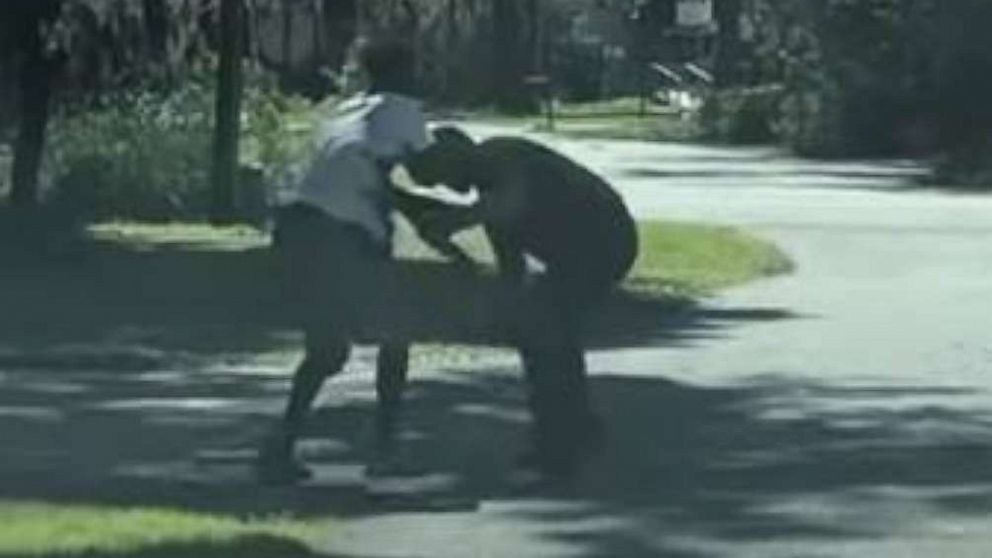[ad_1]
Saying the evidence shows three white suspects “chased, hunted down and ultimately executed” Ahmaud Arbery in Georgia, a prosecutor on Thursday laid out in detail how the 25-year-old black victim tried to run for his life before he was struck by a vehicle and called a racial slur by one of the suspects after being gunned down.
The preliminary hearing for Gregory McMichael, his son Travis McMichael and William “Roddie” Bryan unfolded with graphic details describing the last moments of Arbery’s life.
At one point, testimony from the lead investigator in the case became so graphic Arbery’s mother, Wanda Cooper, walked out of the courtroom.
After hearing hours of evidence from the prosecution, Glynn County Chief Magistrate Judge Wallace E. Harrell rejected requests from the defendants’ attorneys to dismiss the charges. Harrell ordered the McMichaels and Bryan to stand trial on the charges in superior court.
Travis and Gregory McMichael were arrested on May 8, about three months after the killing, and charged with murder and aggravated assault. Bryan, 50, who claimed through his attorney in media interviews that he had no involvement in the incident, was arrested on May 22 and charged with felony murder and criminal attempt to commit false imprisonment.
All three have pleaded not guilty.
Thursday’s hearing occurred at the Glynn County Courthouse in Brunswick, Georgia. Present in the courtroom was Gregory McMichael, 64, a former Georgia police officer, and Travis McMichael, 34. Bryan was not in the courtroom during the hearing.
“We’re here essentially on behalf of the citizens of Glenn County to talk about the fatal shooting of the Feb. 23 incident involving victim Ahmaud Arbery, who was chased, hunted down and ultimately executed we believe the evidence will show based on what’s about to be presented to the court,” said Jesse Evans, an assistant district attorney for the Cobb County District Attorney’s Office, who was appointed special prosecutor in the case.
The only witness called on Thursday was Richard Dial, a special agent for the Georgia Bureau of Investigation, who cited video and direct statements from the suspects in the presentation of the case to the court.
Under direct examination from Evans, Dial said that Bryan told investigators that during the fatal confrontation, he heard Travis McMichael, who allegedly fired the three shots that killed Arbery, yell a racial slur to the victim as he lay dying on the ground.
Dial said that the investigation uncovered other instances in which Travis McMichael used racial slurs in social media posts and in text messages to describe black people.
Arbery was out for an afternoon jog through the Satilla Shores neighborhood of Brunswick when he stopped and went into a house under construction, Dial said. He said a surveillance video showed Arbery, who lived in another neighborhood of Brunswick, inside the unsecured house looking around, possibly for a water source and then leaving.
Dial said Arbery continued jogging past the McMichaels’ home, where Gregory McMichael, who was in front of his residence working on his boat, spotted him and believed he matched the description of a burglary suspect seen on a surveillance video posted online by his neighborhood association.
The investigator said Gregory McMichael armed himself with a .357 Magnum revolver, which had been issued to him when he worked for the Glynn County Police Department, and called his son, who armed himself with a pump-action shotgun. Dial said the father and son got into a pickup truck and chased after Arbery, initially stopping him in front of Bryan’s home in the same neighborhood.
The McMichaels ordered Arbery to stop, but the victim kept running, Dial said.
The father and son chased after him in their truck as Arbery tried to evade them, Dial said.
Bryan also got into his vehicle and attempted to use it to block Arbery’s path several times, Dial said. He said Bryan allegedly struck Arbery during the pursuit hard enough that it left a dent in his vehicle.
Eventually, Arbery found himself trapped between the McMichaels’ truck and Bryan’s vehicle, Dial said. He said Travis McMichael got out of the truck with his shotgun and that he and Arbery began to fight in the street.
Part of the confrontation was caught on a cellphone video taken by Bryan. The footage showed the first shotgun blast hitting Arbery in the chest and showing Arbery’s white T-shirt immediately soaked in blood.
Arbery was shot two additional times, once in the upper left chest and in the right wrist.
After being shot, Arbery attempted to run but collapsed and died at the scene.
In their closing arguments to Harrell, the suspects’ defense attorneys asked that the charges be dismissed.
Travis McMichael’s attorney, Jason Sheffield, said his client only wanted to speak to Arbery about the burglaries in the neighborhood.
“That escalated and Mr. Arbery attacked him in an aggressive way that caused Travis McMichael to fear for his safety,” Sheffield said. “Mr. Travis McMichael used self-defense when he was attacked by Mr. Arbery.”
Franklin Hogue, Gregory McMichael’s attorney, argued that his client should not be charged with murder since he didn’t shoot Arbery. And Bryan’s attorney, Kevin Gough, said his client did not know the McMichaels were allegedly “acting unlawful” when he saw them chasing Arbery and decided to help out.
“He does, with all due respect, what any patriotic American citizen would have done under the same circumstance,” Gough said of Bryan. “The fact that Mr. Bryan does not know what’s going on is his legal defense.”
Evans bristled at Gough’s comments, describing them as “asinine assertions.”
“Any American would have picked up the phone and called 911,” Evans said.
As for Gregory and Travis McMichael’s requests for charges to be dropped, he said, “The blood of that man is on two of these defendant’s hands.”
Evans added, “But for the actions of Gregory McMichael walking into this home and asking his son to arm-up with him, Ahmaud Arbery might very well be alive today.”
[ad_2]
Source link

